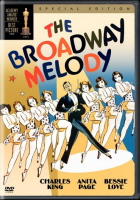 BUY IT AT AMAZON: CLICK HERE!
BUY IT AT AMAZON: CLICK HERE!
STUDIO: Warner Home Video
MSRP: $19.97 RATED: NR
RUNNING TIME: 100 Minutes
SPECIAL FEATURES:
• The Dogway Melody
• Metro Movietone “Reviews”
• Musical: Van & Schenk
• Broadway Trailer Gallery
It does my heart good to see that DVDs like The Broadway Melody are sent to CHUD for review. Oh yeah, we love our genre films here. And we are constantly seeking out the obscure and the B-level films. We celebrate things that are out of the mainstream. Receiving this disk, however, says that somebody at Warner Brothers feels that we can appreciate the history of the medium as well. This film was only the second movie to garner the Academy Award for Best Picture. It solidified quite a few aspects of how musicals would be represented on screen. It also spawned sequels! Sequels! The Broadway Melody is a major event in film history.
Now let’s see if we can appreciate the hell out of it.
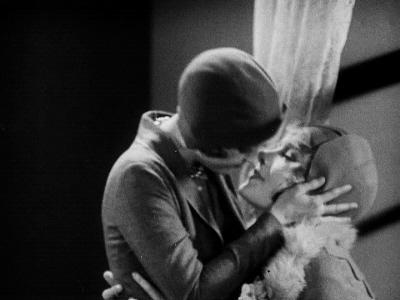
"And the Award for Best Picture goes to…
Nice choice, gentlemen!"
The Flick
Just two short years after Al Jolson uttered those famous words, “wait a minute! Wait a minute! You ain’t heard nothin’ yet!” the first of the Broadway Melody films was released. It was advertised as “All Talking! All Singing! All Dancing!” in a time when advertising that your film had sound was a necessary step. It was directed by Harry Beaumont who was a veteran of film. Prior to this, Beaumont had directed over 30 films all of which were silent. Certain elements in this film point toward his unfamiliarity to the new technology the most obviously being the title cards announcing the chapters. The actors are still directed to project their acting; a yawn becomes a full body stretch, drunken characters hiccup and stagger as though completely out of their minds. Otherwise Beaumont did a phenomenal job on his first Talkie.
Queenie (Anita Page, Witchcraft XI) and Hank Mahoney (Bessie Love, Lady Chatterley’s Lover) have been touring their act around the country and have hit Broadway to make it big. Fortunately they have an in with Hank’s fiancé Eddie Kearns (Charles King who would pass away 15 years later of pneumonia) who already works on The Great White Way as a singer/dancer/songwriter. Unfortunately for Hank when Eddie sees how her sister Queenie has “developed” as a performer his thoughts of Hank romantically dry up completely. With Hank being the driving force of the duo, this turn of events would cause a serious obstacle to their careers on stage. To keep this from happening, Eddie hides his feelings from Hank and only professes his love to Queenie in private. You know, like a snake in the grass pansy might do. Queenie, the apparently stronger of the two, tries to date outside this love triangle and move on. Enter Jock Warriner (Kenneth Thomson, the perpetual extra) as a rich man looking for a trophy wife amongst the plethora of hot girls working chorus lines on musical productions. Jock’s reasons for wanting to possess Queenie are no more gallant that Eddie’s but he is in the more honorable position of not being Queenie’s sister’s fiancé. Of course he isn’t the lead so he’s automatically the bad guy.
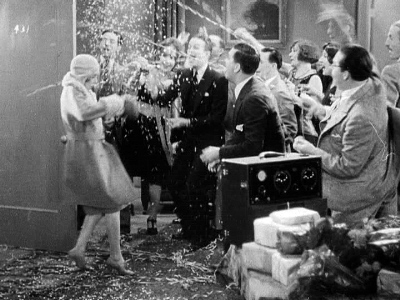
Getting on the bad side of the confetti-spewing pod people from Saturn
is really not that unpleasant an experience.
With the conflict established, we get many scenes of people suffering in silence. Hank is no fool; she sees what’s happening between her fiancé and her sister. So we get to see characters martyr themselves by holding their secrets in and other characters knowing those secrets and in turn not letting on with their pain. All so that the show will go on. And what a show it is! A full fifty percent of the scenes in this film are shot directly on the Zanfield stage (a thinly veiled Ziegfield reference). Dancing girls, comedy bits and big production songs grace the screen in all the spectacle you’d expect. In comparison the Mahoney sister’s spotlight seems very lame indeed. They sing “The Boy Friend” while hugging each other very close. Yes, it’s sexy but amongst the much more talented performers they truly seem out of place. Off stage we get a few numbers as well. During one of Eddie’s cowardly surreptitious advances on Queenie, he sings “You Were Meant For Me” starting the curious technique by musicals to have characters burst into song with full orchestra backup. It is interesting to note that Eddie claims to have written the song exclusively for Queenie, yet later that night the song is heard at a local speakeasy being played by a full orchestra. What makes it funnier is that his lie is not addressed so the assumption here is that this is merely a gaping plothole.
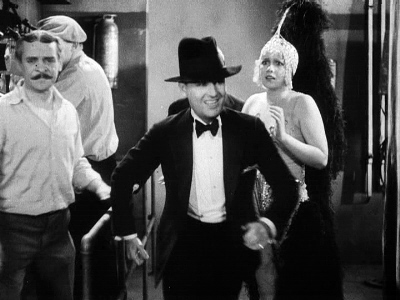
No woman escapes unaffected by "The Strut"!
Barbershop quartet guys, however, could care less.
I would also like to mention the Mahoney Sister’s manager. Uncle Jed, played by Jed Prouty (1937’s A Star Is Born), has a speech impediment manifesting itself as a stutter. This kind of humor is frowned on anymore as evidenced by the backlash received by A Fish Called Wanda some 59 years later. The comedy comes from the character trying to spit out a phrase, stuttering, then finally saying a different sentence that means approximately the same thing. You know, like Porky Pig. I seem to recall hearing that the pig’s character was based on Uncle Jed, but I could not find any evidence of this for the purposes of this review. Suffice to say that Porky Pig did not appear for the first time until 6 years later.
The Broadway Melody is definitely a milestone in film history. As such it is a great way to flesh out one’s understanding of early film and the first films to incorporate audio. Is it as important to see as The Jazz Singer? Well, no. You’d have to have a pretty strict definition of a musical not to count The Jazz Singer as the first in that genre. This film is more along the lines of a solidification of how musicals would be presented. In this light it’s really more comparable to The Cabinet of Dr. Caligari in the use of stylistic choices that would later be copied. Having people burst into song with music magically accompanying them and supposedly unrehearsed and complicated choreography appear from nowhere. This is what we have to thank The Broadway Melody for.
7.9 out of 10
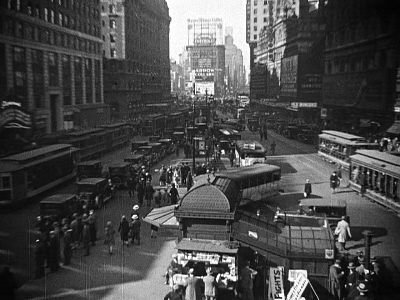
Seen here is a photo of pre-Disnification Times Square. 30 years after the Disney influence, the prostitutes and smut-peddlers would be removed.
The Look
Oh, yeah it has all the scratches and spots you’d expect from a film over seventy-five years old. I’m not sure how much of it they could have cleaned out, but it really isn’t necessary. The scratches are part of the charm and I’d have it no other way. Not to say there wasn’t some restoration done here: the picture is remarkable clean given the circumstances. As most of you undoubtedly know, widescreen ratio wasn’t invented yet so the standard format in this case IS the original aspect ratio. As you watch this film you’ll notice that the picture will darken and lighten ever so slightly like someone is fiddling with the F-stop during filming. It’s hardly noticeable and only mentioned here in the interest of being thorough. You won’t hear me complain.
7.8 out of 10
The Noise
Surprisingly clear. It’s mono as you’d expect and every word is clear as a bell. This is some great work as I have a few DVDs from post-2000 where I need the subtitles to understand the dialogue. This is one of those relativity scores in that the bass doesn’t blow you out of your chair and your surround sound system will get no workout. However, they’ve done a fine job making sure you can enjoy this flick without annoying snaps and pops.
8.2 out of 10
The Goodies
What Warner Brothers has done for us here is what I like to refer to as “Kitchen Sink Extras”. They’ve grabbed all kinds of stuff from their vault that pertains to the late 20s, early 30s and has singing, dancing or both and tossed it onto this disk. I love this stuff as it’s a great way to immerse oneself into the timeframe. Way to go, Warners!
The Dogway Melody – Here’s something you don’t see everyday: a parody of a movie found on the DVD of the movie parodied. This 16 minute short spoofs the original The Broadway Melody with a cast comprised entirely of canines (not counting the human hands these dogs sometimes magically produce when expressive moments are needed). Is it funny? Let me repeat: it’s a short film cast exclusively with dogs! Of course it’s hilarious! It’s films like this that broke ground for Bugsy Malone and the films of Steve Oedekerk.

Sorry, folks. No caption. I just think this is funny.
Metro Movietone “Reviews” – You’ll notice the word “Reviews” in quotes. Although technically that is an accepted spelling, the word is “revues” and that is how it is spelled on the actual film clips. The DVD menu (or should I say “meniew”) uses the former spelling and it sticks out like a sore thumb. These are five shorts less than 20 minutes each of some singing and dancing and comedy bits taken directly from the stage. The cool thing about early talkies and early film in general is that the medium was so new people didn’t require a structure for their entertainment yet. Full length feature films were great, but cartoons and little revues were stuck in between as filler. Going to the movies was almost akin to a different talent show every week. Or, moreover, going to the theatre and watching revues.
Musical: Van & Schenk – This 5 minute short has Gus Van (no “Sant”) and Joe Schenk singing “Chinese Firecracker” and “Way Down South” with a piano accompaniment. They sing in that warbly, old-timey way that sounds like they have a megaphone.
Broadway Trailer Gallery – The Broadway Melody was such a hit that it spawned sequels. Can you imagine that? This is a great example for people who think that sequels and adaptations are a relatively recent blight on creative thought in Hollywood. Ha! It’s always been there, man! Found under this heading are trailers for the four sequels to the movie reviewed above (Ironically, a trailer for the movie reviewed above is not present). The trailers are:
Broadway Melody of 1936 – The title is somewhat of a misnomer, it was released in 1935. The trailer shows Jack Benny (sans Rochester), Buddy Ebsen (his talents shown here make the knowledge that he was the original Tin Man make much more sense), and the heartthrob that is Robert Taylor.
Broadway Melody of 1938 – Quite a few of the cast from 1936 return with the addition of gay icon Judy Garland.
Broadway Melody of 1940 – TAP! Unless the trailer lies, this movie has nothing but tap dancing. If you like the tap then this is your movie. Robert Taylor has been ditched for the much more bobbly-headed Fred Astaire and he dances with… Eleanor Powell? Just goes to show you that even Fred and Ginger needed time apart.
Broadway Rhythm – The working title for this film was Broadway Melody of 1944, but this one was more about the rhythm, baby. Broadway Rhythm is a nice reminder that we could have blacks in pre-1950s film where they weren’t playing slaves or servants. The cast includes the beautiful Lena Horne, Rochester (sans Jack Benny) and Nancy Walker. Yeah, THAT Nancy Walker; Rhoda Morgenstern! She’s so young here!

"Why won’t it wash away?! Damn you, Strut-man!"
I have been politely chastised on the message boards for scoring the extras section too high when commentaries aren’t present. It’s a good point and the truth is Warner Brothers could have hired a professor to speak about this film and its impact on musicals. But frankly there is so much stuff in here that I can’t imagine there is a 1 or a 0 left over for it. This thing is packed!
9.0 out of 10
The Artwork
This is a very Hirschfeld-looking piece of art featuring one guy with top hat, cane and tails and seven dancing girls. You couldn’t find more truth in advertising anywhere. Plus, it’s a snappy looking cover. Too bad the Warners felt it was necessary to throw in that gaudy square at the top to remind us that this won the Academy Award. Tacky, man. Otherwise, aces.
8.1 out of 10
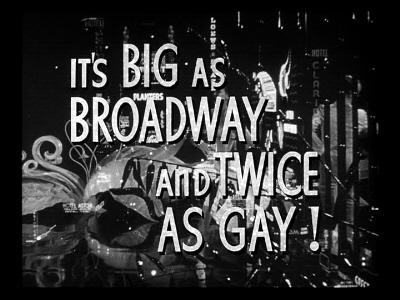
Snicker.
Overall: 8.2 out of 10